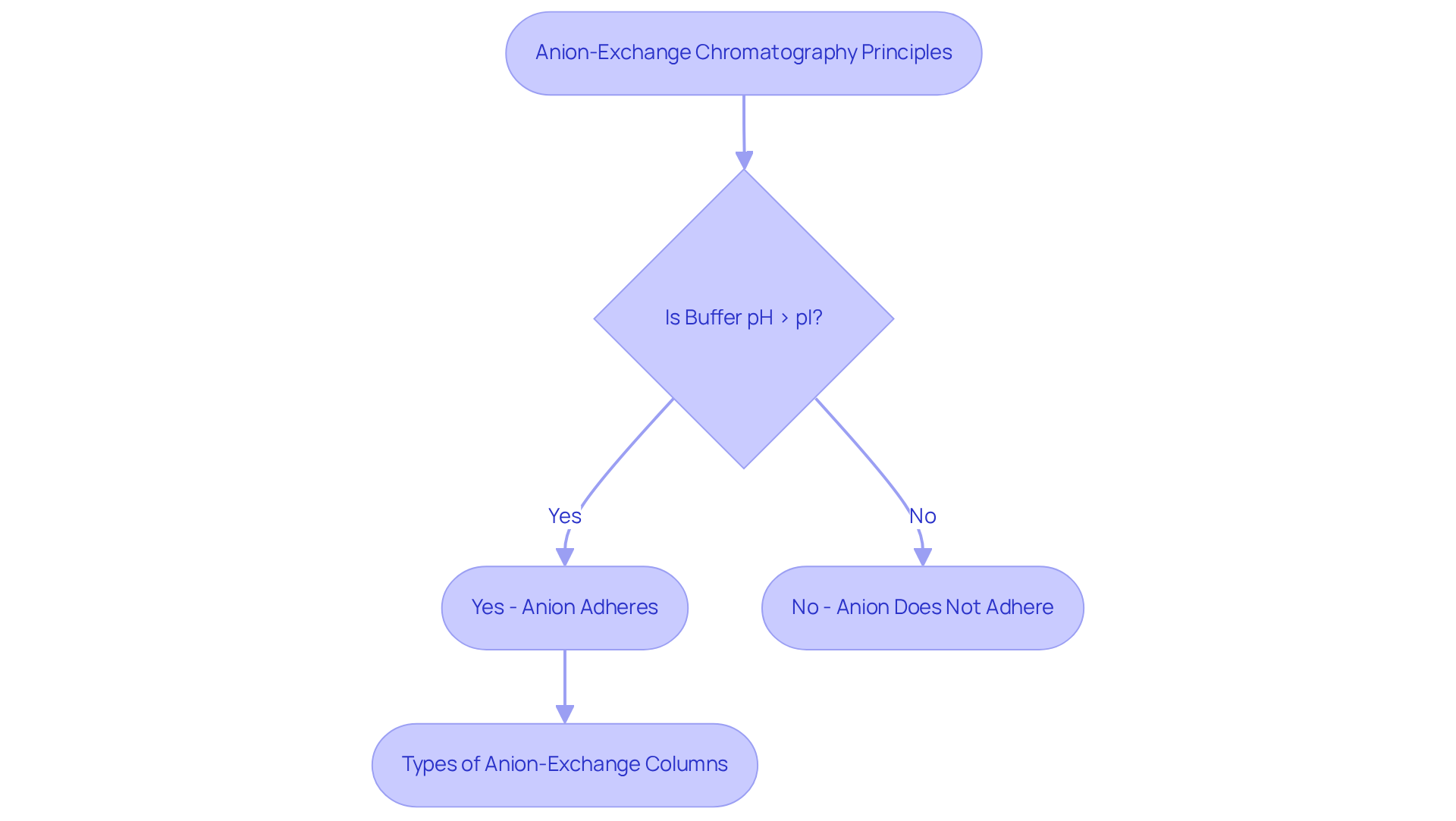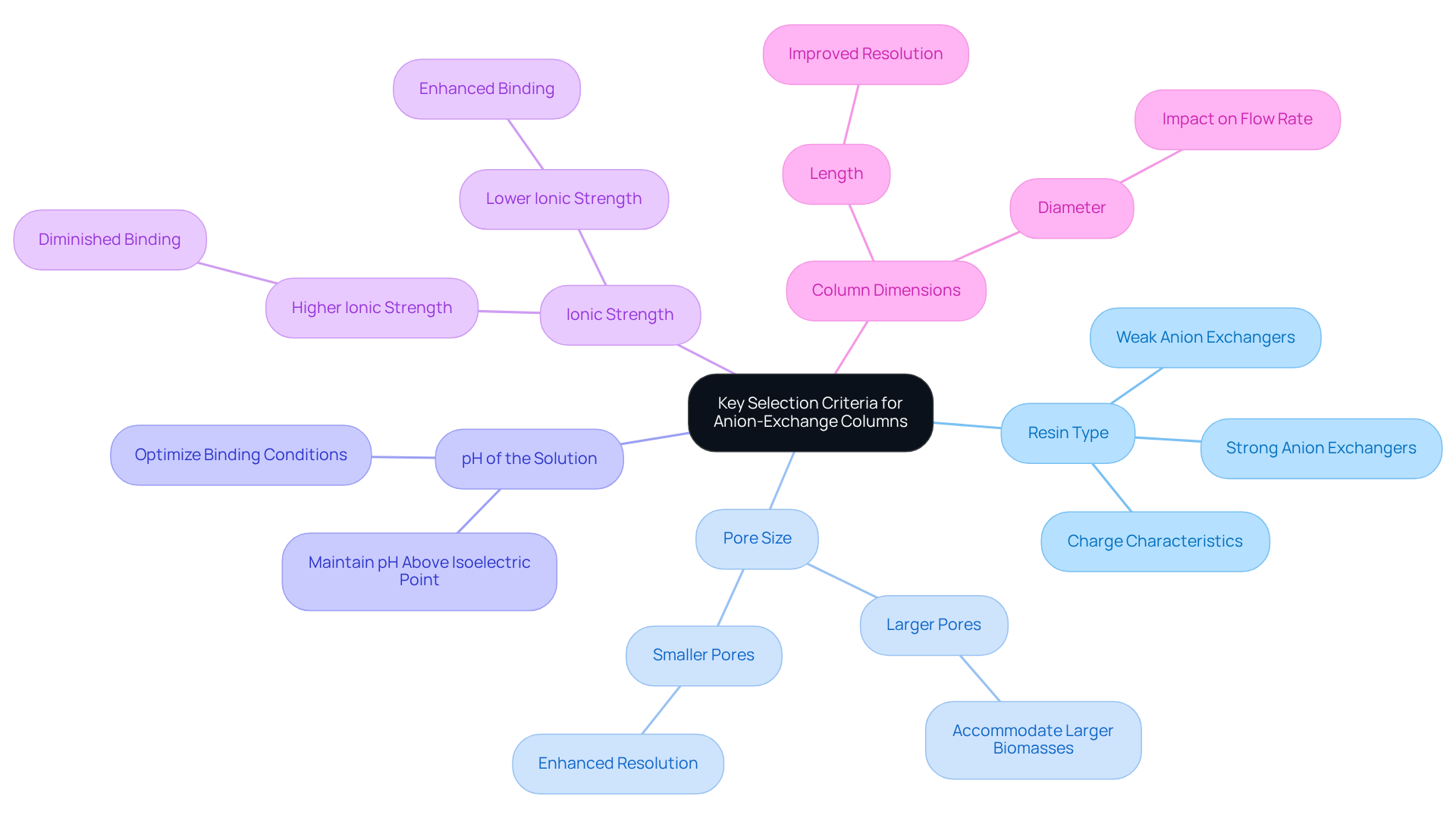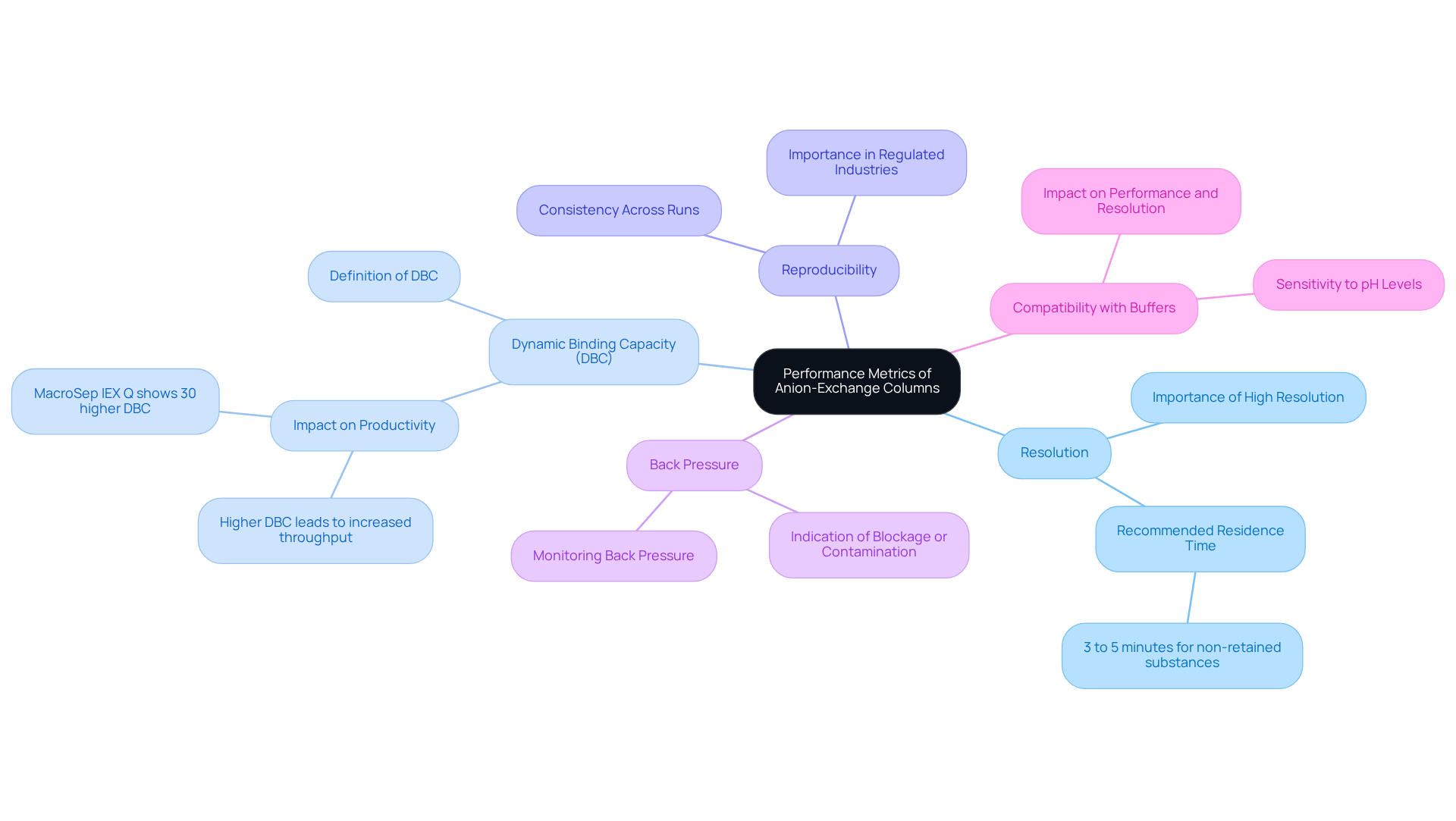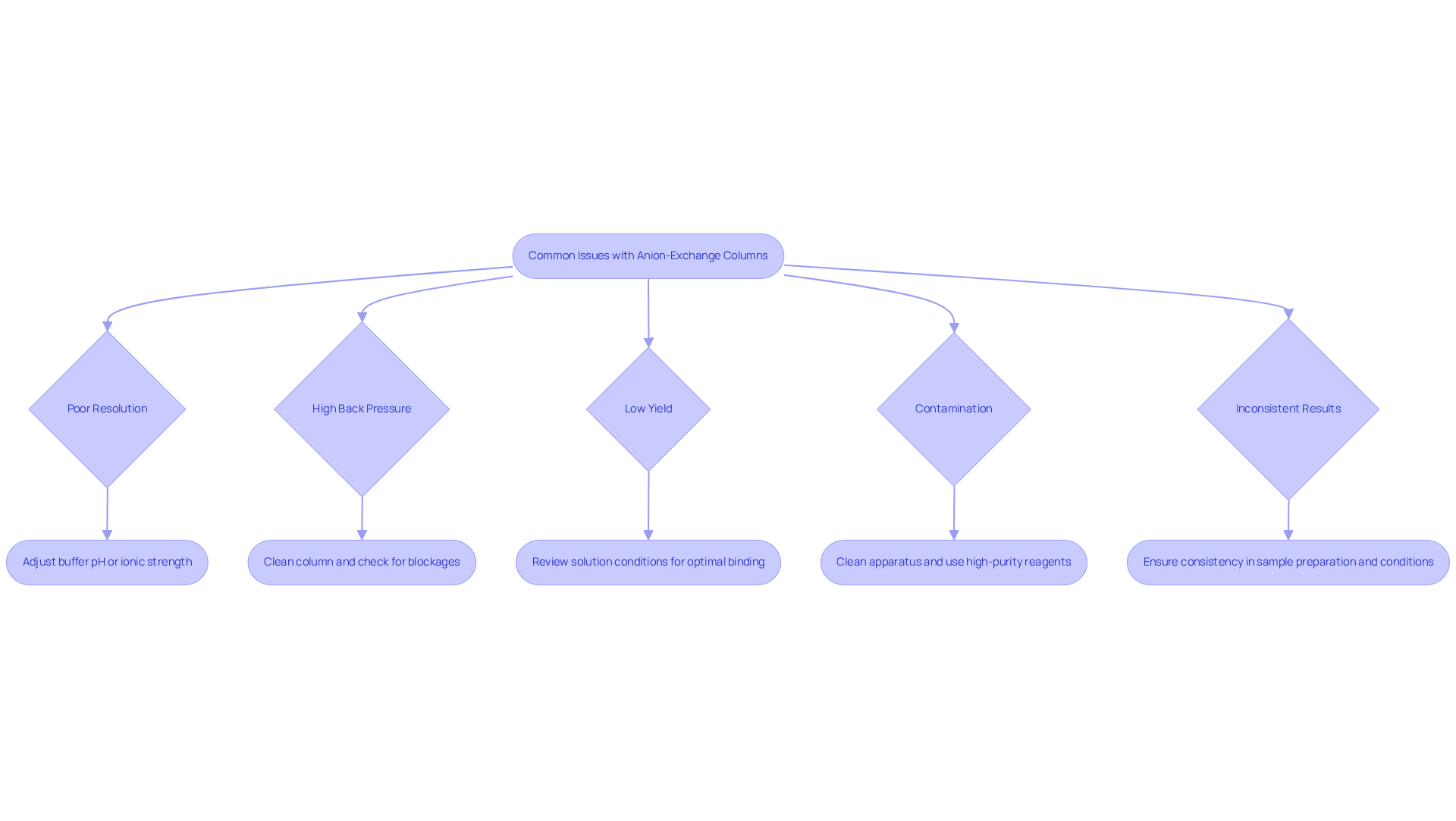Overview
This article examines the critical criteria for selecting and troubleshooting anion-exchange columns in chromatography. It underscores the importance of factors such as resin type, pH, and dynamic binding capacity. By providing detailed troubleshooting steps for common issues, the article aims to ensure optimal performance and reliability in analytical applications. Understanding these elements is essential for achieving high-quality results in laboratory settings. Therefore, readers are encouraged to consider these factors carefully to enhance their analytical processes.
Introduction
Anion-exchange chromatography is essential for the separation and purification of negatively charged molecules. However, the complexities of column selection and troubleshooting can present significant challenges for researchers. Understanding the principles behind this technique—particularly the roles of pH and isoelectric points—is critical for optimizing outcomes.
With a variety of column types, performance metrics, and common challenges to navigate, how can one secure the best results in their chromatography efforts? This guide explores the intricacies of selecting the appropriate anion-exchange column and effectively troubleshooting issues, empowering researchers to enhance their analytical processes.
Understand Anion-Exchange Chromatography Principles
The anion-exchange column chromatography stands as a pivotal method for separating negatively charged entities, known as anions, based on their charge characteristics. This technique employs an anion-exchange column with a positively charged stationary phase that effectively attracts and binds anions from the mobile phase.
The key to successful separation lies in understanding the isoelectric point (pI) of the target substances alongside the pH of the utilized solution. When the buffer's pH surpasses the , it remains negatively charged and adheres to the positively charged material. This principle is essential for optimizing the separation process, ensuring high purity in the final product.
Additionally, familiarity with various types of anion-exchange columns, including strong and weak anion exchangers, is crucial, as they exhibit differing binding capacities and selectivity.

Identify Key Selection Criteria for Anion-Exchange Columns
When selecting an , it is essential to consider several key criteria to ensure optimal performance in pharmaceutical applications.
- Resin Type: Choosing between strong and weak anion exchangers is crucial, as it depends on the charge characteristics of the target compound. Strong anion exchangers cater to a broad range of pH conditions, while weak anion exchangers offer selectivity for specific applications. As Omprakash G. Bhusnure observes, "Ion exchange chromatography involves the separation of ionizable substances based on their total charge," highlighting the importance of selecting the appropriate material.
- Pore Size: The resin's pore size directly impacts binding capacity and resolution. Larger pores may be necessary for accommodating larger biomasses, whereas smaller pores can provide enhanced resolution for smaller entities, making them ideal for precise separations.
- pH of the Solution: It is essential to adjust the solution's pH to ensure that the target substances remain negatively charged. Typically, the solution pH should be maintained at 0.5 to 1 unit above the isoelectric point (pI) of the target molecule to optimize binding conditions.
- Ionic Strength: The ionic strength of the buffer significantly influences binding interactions. A higher ionic strength may diminish binding, while a lower ionic strength can enhance it, necessitating careful optimization based on the specific application.
- Column Dimensions: The dimensions of the column, including length and diameter, can affect both resolution and flow rate. Longer columns generally provide improved resolution but may increase back pressure, which must be managed effectively.
In light of current trends, there is a noticeable shift towards smaller internal diameter tubes, which enhance sensitivity and reduce solvent usage. This trend is reflected in the growing Ion Exchange HPLC Column market, projected to reach USD 4.41 Billion by 2031, with a CAGR of 9.2% during the forecast period from 2024 to 2031. By thoughtfully evaluating these criteria and staying updated on market dynamics, researchers can select the most suitable anion-exchange column tailored to their specific analytical needs, ensuring optimal performance in their applications.

Evaluate Performance Metrics and Compatibility of Columns
To evaluate the performance of the anion-exchange column, it is essential to consider several key metrics that underscore its effectiveness.
- Resolution is a critical metric reflecting the column's ability to separate various anions. High resolution is paramount for applications requiring exceptional purity, such as protein purification, where even minor impurities can significantly impact results. A recommended residence time of 3 to 5 minutes for non-retained substances is vital for accurately assessing resolution.
- Next, consider [Dynamic Binding Capacity](https://jmscience.com/collections/karl-fischer-titrators?srsltid=AfmBOopzNPxO1w0YcjYOPKxBqh8mibyZEAdeFkqqt9a8dV43gKDjblEA) (DBC), which measures the maximum quantity of target molecules that can adhere to the material under specific conditions, typically expressed in mg of bound protein per mL of the medium. Recent studies highlight that elevated DBC values are crucial for enhancing productivity in downstream processing, facilitating increased throughput and fewer cycle counts. For instance, MacroSep IEX Q exhibits a 30% greater dynamic binding capacity compared to alternative resins, underscoring the importance of selecting the right medium.
- Reproducibility is another vital aspect, as consistency in results across multiple runs is essential for reliable data. Evaluating the performance of the column over time ensures it maintains its effectiveness, which is particularly important in regulated industries like pharmaceuticals.
- Monitoring Back Pressure during operation is also crucial. An increase in back pressure may signal blockage or contamination, necessitating maintenance or replacement of the column to avert compromised performance.
- Lastly, assess the Compatibility with Buffers. It is imperative to ensure that the selected column is compatible with the buffers and solvents utilized in your application. Some columns may exhibit sensitivity to certain pH levels or ionic strengths, which can significantly affect performance and resolution.
By systematically evaluating these performance metrics, researchers can ascertain that their selected anion-exchange columns are appropriate for their specific applications. This assessment not only aids in troubleshooting potential issues during chromatography but also emphasizes the importance of integrating , particularly those related to DBC measurement, to enhance the overall evaluation process.

Troubleshoot Common Issues with Anion-Exchange Columns
Common issues encountered with the use of anion-exchange columns can significantly impact the reliability of chromatography results. Addressing these challenges is crucial for achieving optimal performance in laboratory settings.
- Poor Resolution: When peaks are not well-separated, it is essential to adjust the buffer pH or ionic strength. Proper equilibration of the column before use is also vital to ensure accurate results.
- High Back Pressure: Increased back pressure may signal clogging due to particulate matter or resin degradation. Following the manufacturer's recommendations for cleaning the column and checking for any blockages in the system is necessary to maintain flow efficiency.
- Low Yield: A low yield of the target molecule necessitates a review of the solution conditions for optimal binding. Adjusting the pH and ionic strength can enhance binding efficiency, thereby improving yield outcomes.
- Contamination: Contamination can lead to unexpected results, undermining the integrity of experiments. It is critical to consistently clean the apparatus and utilize high-purity reagents to mitigate contamination risks.
- Inconsistent Results: Discrepancies in outcomes between experiments may arise from variations in sample preparation, buffer conditions, or equipment maintenance. Ensuring consistency across all parameters is fundamental to achieving reproducible results.
By adhering to these troubleshooting steps, researchers can effectively address common issues with the anion-exchange column. This proactive approach not only but also reinforces the credibility of chromatography applications in scientific research.

Conclusion
Understanding the nuances of anion-exchange chromatography is essential for achieving successful separation and purification of negatively charged molecules. The selection and optimization of anion-exchange columns hinge on critical factors such as:
- Resin type
- Pore size
- pH
- Ionic strength
- Column dimensions
Mastery of these elements not only enhances the efficiency of chromatography processes but also ensures high purity and reproducibility of results.
The article has outlined key considerations for selecting anion-exchange columns, emphasizing the importance of:
- Dynamic binding capacity
- Resolution
- Compatibility with various buffers
Furthermore, troubleshooting common issues—such as poor resolution, high back pressure, and contamination—has been highlighted as a vital practice for maintaining effective chromatography. By diligently applying these insights, researchers can significantly improve their chromatography outcomes and streamline their analytical processes.
In conclusion, the significance of informed column selection and proactive troubleshooting in anion-exchange chromatography cannot be overstated. As the field continues to evolve, staying abreast of best practices and emerging trends will empower researchers to refine their techniques and enhance the reliability of their results. Embracing these principles not only contributes to individual success but also advances the broader scientific community's understanding of complex biochemical interactions.




